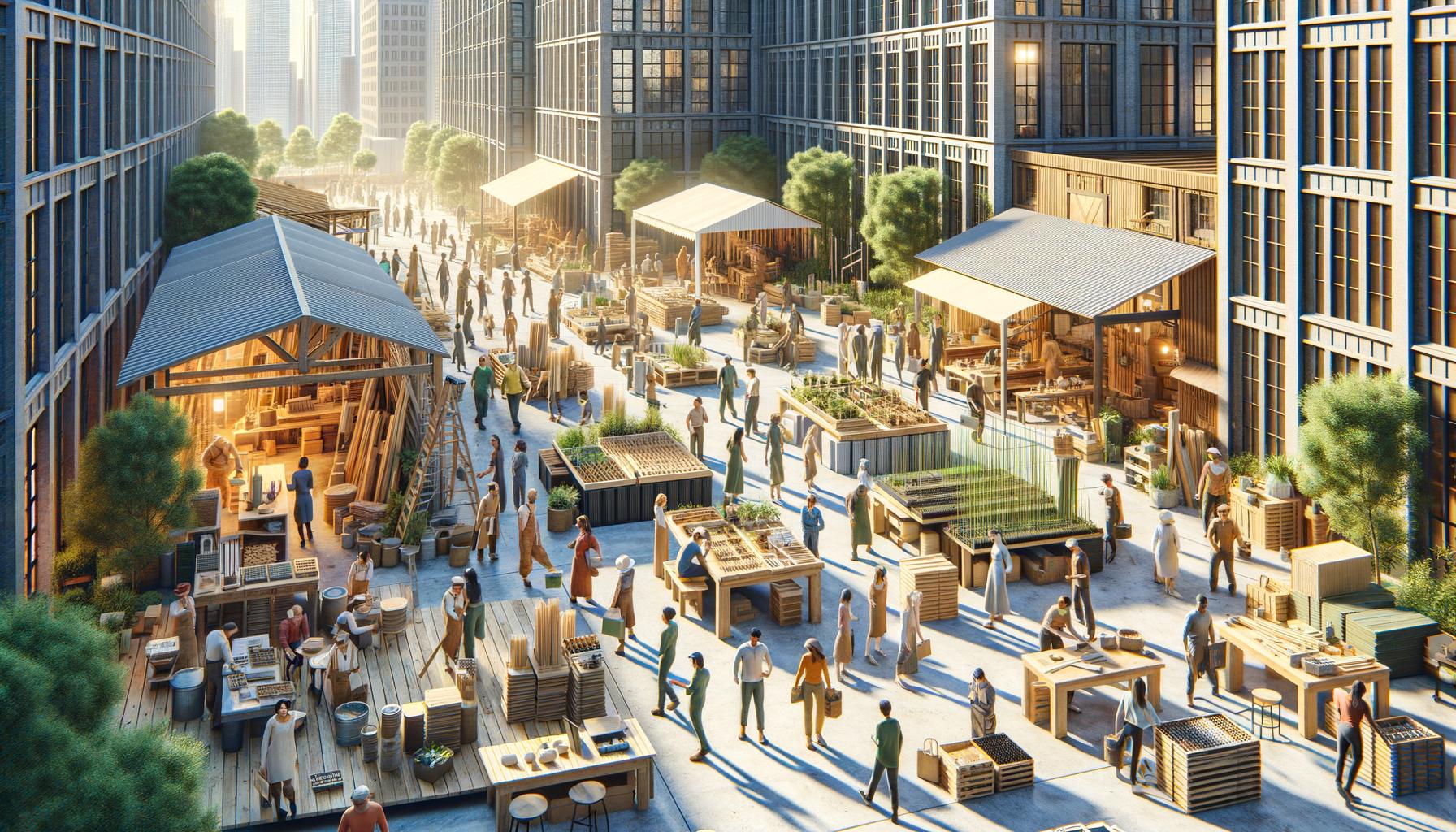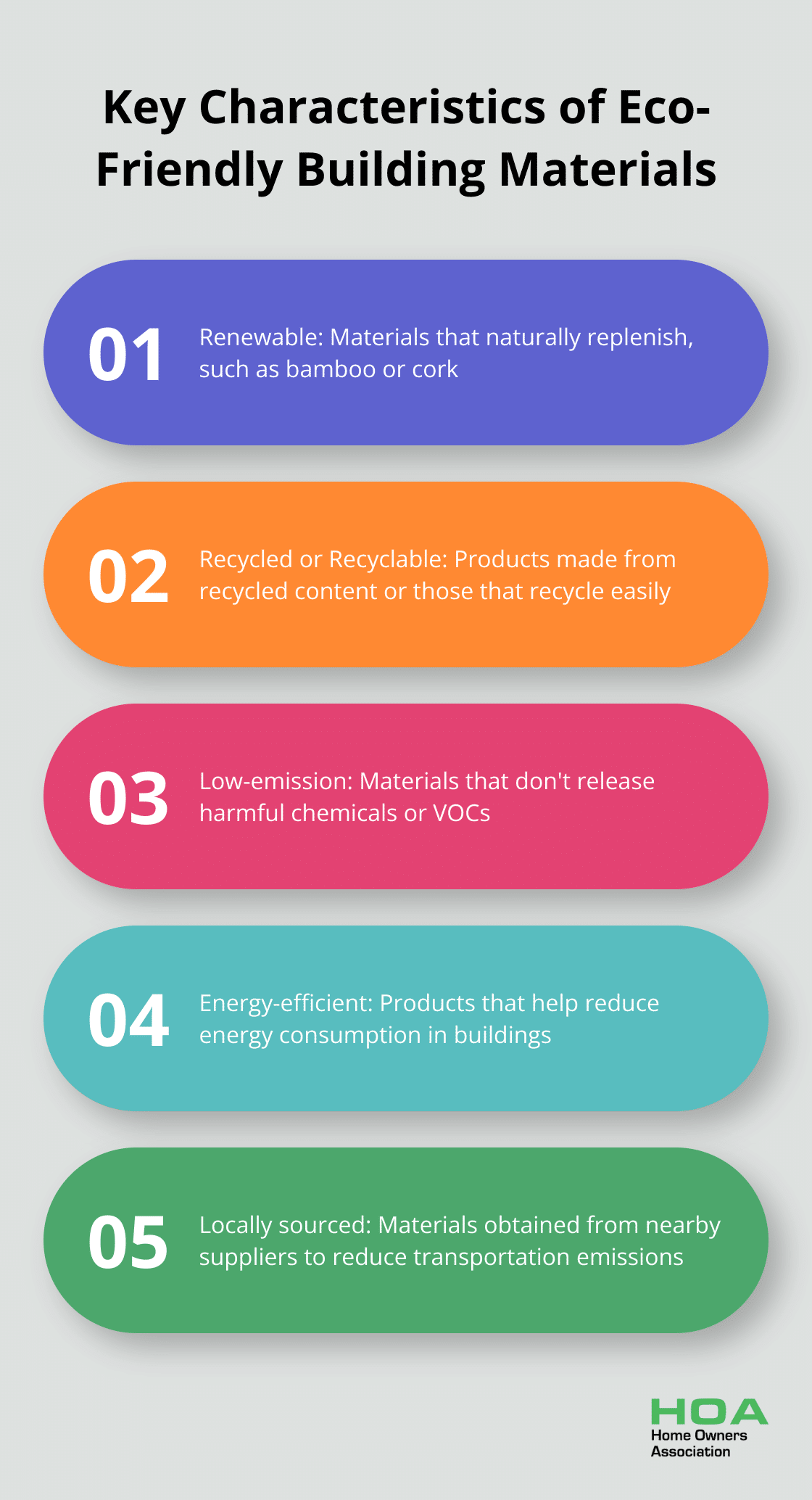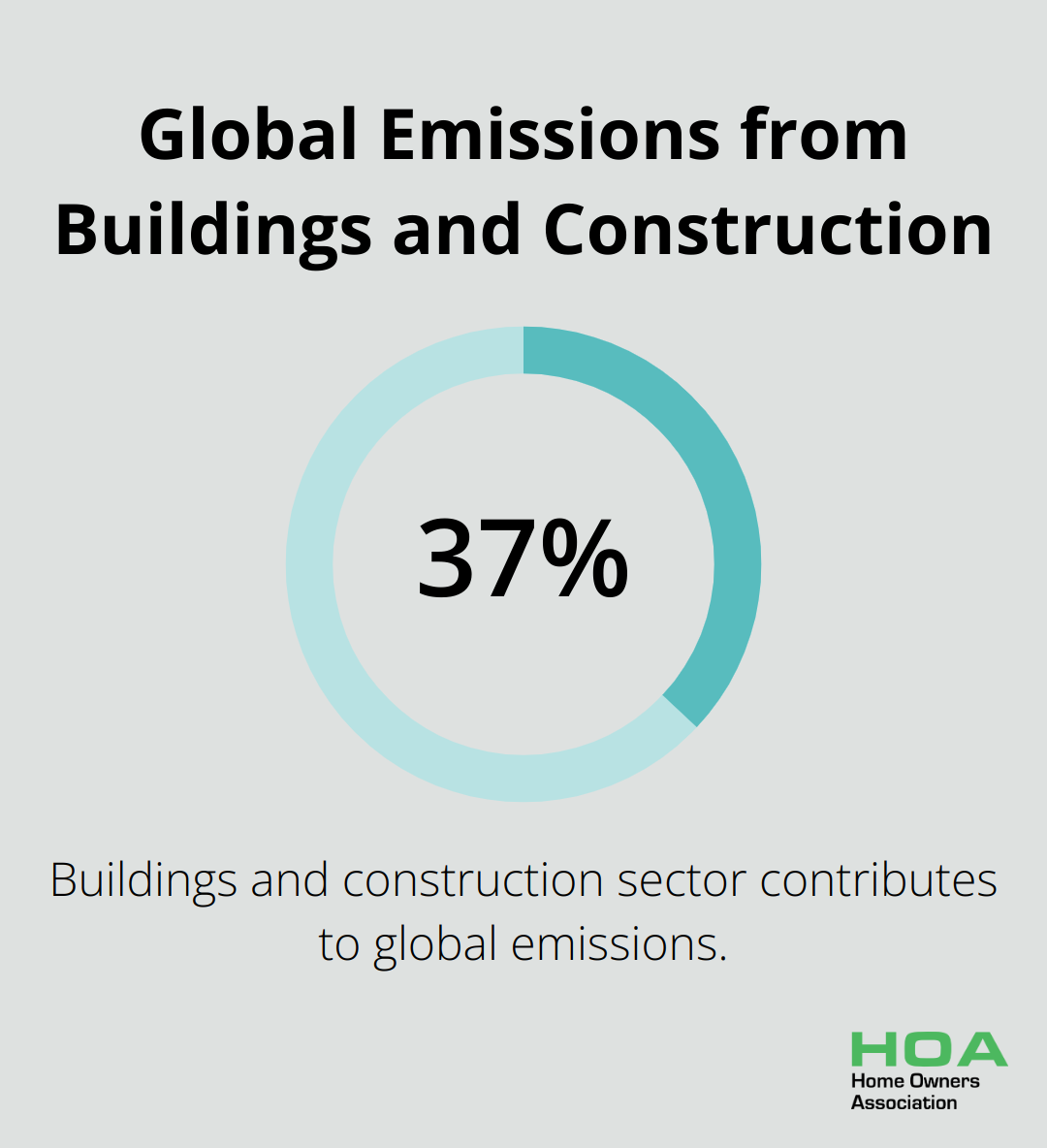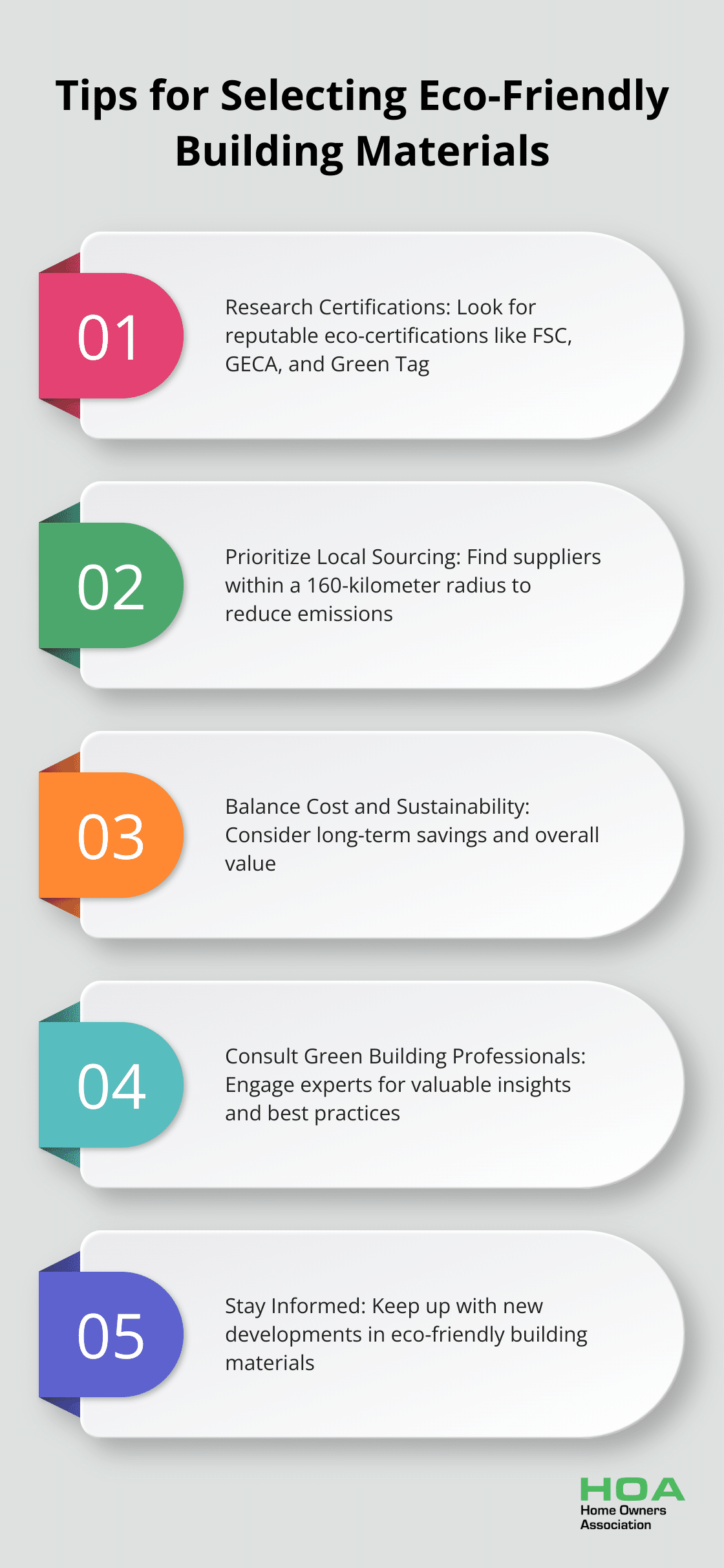
At Home Owners Association, we understand the growing importance of sustainable construction practices. Choosing environmentally friendly building materials is a key step in reducing your home’s carbon footprint and creating a healthier living space.
This guide will help you navigate the world of eco-friendly building materials, from understanding their characteristics to evaluating their environmental impact. We’ll also provide practical tips for selecting the best sustainable options for your next home project.
What Are Eco-Friendly Building Materials?
Definition and Importance
Eco-friendly building materials minimize environmental impact throughout their lifecycle. These products reduce resource consumption, lower carbon emissions, and promote healthier living spaces. The demand for sustainable construction options has increased significantly in recent years.
Key Characteristics
When selecting eco-friendly building materials, look for products that possess the following attributes:
- Renewable: Materials that naturally replenish, such as bamboo or cork.
- Recycled or Recyclable: Products made from recycled content or those that recycle easily at the end of their life.
- Low-emission: Materials that don’t release harmful chemicals or volatile organic compounds (VOCs).
- Energy-efficient: Products that help reduce energy consumption in buildings.
- Locally sourced: Materials obtained from nearby suppliers to reduce transportation emissions.

Popular Sustainable Options
Several eco-friendly materials have gained popularity:
- Recycled Steel: Using recycled steel in construction can significantly reduce energy consumption.
- Bamboo: This fast-growing grass serves as a highly sustainable alternative to hardwoods.
- Hempcrete: This material provides excellent insulation properties.
- Reclaimed Wood: Using reclaimed wood reduces landfill waste by up to 8,000 pounds for a 2,000 square foot home.
- Low-VOC Paints: These paints can help decrease indoor air pollution.
Performance Evaluation
Assessing long-term performance is essential when considering eco-friendly options. For example, fiber cement siding can have a long lifespan, potentially outperforming other siding options. This durability reduces replacement needs and decreases overall waste.
The National Construction Code of Australia sets minimum energy efficiency standards for new homes, emphasizing the importance of high R-value materials. Pay close attention to these ratings when selecting insulation or other building components to ensure optimal energy performance.
Properties built with eco-friendly materials often see higher market values, reflecting the growing prioritization of sustainability among Australian homebuyers.
As we move forward, it’s important to understand how to evaluate the environmental impact of these materials beyond their basic characteristics. The next section will explore life cycle assessments, energy efficiency, and recycling potential to help you make informed decisions about sustainable building materials.
How We Measure Environmental Impact
Life Cycle Assessment
Life cycle assessment (LCA) provides a comprehensive evaluation of a material’s environmental impact from extraction to disposal. The Green Building Council of Australia offers LCA tools to quantify these impacts. The buildings and construction sector accounts for 37% of global emissions. In contrast, hempcrete absorbs carbon dioxide during its lifetime, making it carbon-negative. We recommend selecting materials with lower overall emissions throughout their life cycle.

Energy Efficiency and Insulation
Energy-efficient materials reduce a home’s long-term environmental impact. A University of Melbourne study found that homes built with eco-friendly materials had 50% fewer airborne pollutants compared to traditional builds. Insulation plays a key role in energy efficiency. Straw bale insulation achieves high R-values, resulting in substantial energy savings. Earthwool (made from 80% recycled glass bottles) stands out as a top eco-friendly insulation material that improves indoor air quality.
Recycled Content and Recyclability
Materials with high recycled content or easy recyclability conserve resources and reduce waste. The Steel Recycling Institute reports that using recycled steel in construction saves enough energy to power 18 million households for a year. We suggest choosing materials with high recycled content. Some fiber cement siding products contain up to 50% recycled content. Consider the material’s end-of-life recyclability as well. Sustainably sourced timber often allows for repurposing or recycling at the end of its life in a building.
Local Sourcing
Sourcing materials locally reduces transportation emissions and supports local economies. Try to find suppliers within a 160-kilometer radius. This approach not only minimizes the carbon footprint associated with transportation but also contributes to the local economy. Local sourcing often results in fresher materials and better quality control (due to shorter supply chains).
Certifications and Labels
Look for materials with recognized eco-certifications. The Forest Stewardship Council (FSC) certification ensures wood products come from responsibly managed forests. Other important labels include Good Environmental Choice Australia (GECA) and Green Tag. These certifications provide assurance that the materials meet rigorous environmental standards.
The next chapter will provide practical tips on how to apply this knowledge when selecting eco-friendly building materials for your project.
How to Select Eco-Friendly Materials
Research Certifications and Labels
Start your selection process by understanding reputable eco-certifications. The Forest Stewardship Council (FSC) certification ensures products come from responsibly managed forests. Look for the Good Environmental Choice Australia (GECA) label, which indicates products meet strict environmental standards. The Green Tag certification also serves as a reliable indicator of sustainability.
Don’t accept marketing claims at face value. Investigate the meaning and awarding process of these certifications. The Australian Government’s YourHome initiative offers a comprehensive guide to various eco-labels and their importance in the construction industry.
Prioritize Local Sourcing
Local material sourcing reduces transportation emissions and supports your community’s economy. Try to find suppliers within a 160-kilometer radius of your project site. This approach often yields fresher materials and improved quality control (due to shorter supply chains).
Contact your local council or building associations for lists of nearby suppliers who specialize in eco-friendly materials. Many regions maintain directories of sustainable businesses, which simplify the process of finding what you need close to home.
Balance Cost and Sustainability
Eco-friendly materials may have higher upfront costs but often result in long-term savings through energy efficiency and durability. For example, fiber cement siding is highly durable and resistant to fire, insects, and rot.
Create a budget that considers both initial costs and long-term benefits. The Green Building Council of Australia provides tools to calculate the lifecycle costs of different materials. This approach allows you to make decisions based on overall value rather than just upfront expenses.
Consult Green Building Professionals
Engage with experts in sustainable construction to gain valuable insights and save time and money. These professionals stay updated on the latest eco-friendly materials and techniques, ensuring your project meets current best practices.
The Australian Institute of Architects maintains a directory of architects who specialize in sustainable design. Additionally, the Green Building Institute offers training for professionals in eco-friendly construction methods, making their graduates excellent resources for your project.
Stay Informed About New Developments
The field of eco-friendly building materials evolves rapidly. Stay informed about new products and technologies entering the market. Industry publications and sustainable building expos provide great opportunities to keep up with the latest developments in green construction materials.

Final Thoughts
Environmentally friendly building materials offer a powerful way to create sustainable homes and reduce ecological footprints. These materials prioritize renewable resources, recycled content, and low emissions, which contribute to a healthier planet and living spaces. The selection process requires thorough research, understanding of certifications, and a balance between cost and long-term benefits.
Local sourcing minimizes transportation emissions and supports community economies. Green building professionals provide valuable insights that align projects with the latest sustainable practices. While eco-friendly options may have higher upfront costs, they often result in significant long-term savings through improved energy efficiency and durability (especially in the case of materials like fiber cement siding).
We at Home Owners Association encourage you to embrace sustainable choices in your home projects. Your decisions have a lasting impact on both your living space and the world around you. Every environmentally conscious choice in home construction brings us closer to a greener, healthier future for Melbourne and beyond.





